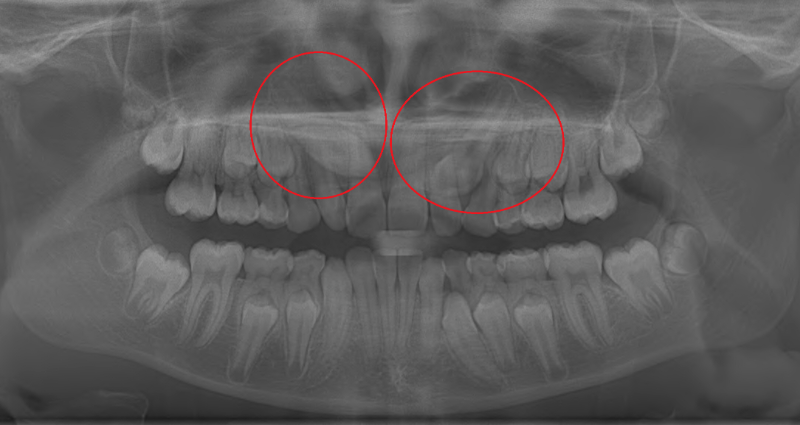
Orthodontics is used to improve or correct a wide range of dental health concerns. It’s the visible problems that people think of, including crooked and crowded teeth, but braces can sometimes fix the ‘invisible’ problem of impacted teeth.
What is an Impacted Tooth?
An impacted tooth is a common dental problem. Impaction occurs when a tooth grows at an angle or moves into the gum space needed by another tooth. An impacted tooth can damage the root or crown of surrounding teeth. If the damage is severe and left untreated, the impacted tooth can cause a neighbouring tooth to loosen and fall out.
Types of Impaction
Multiple teeth can be diagnosed as impacted. Majority of the teeth observed in the orthodontic setting involve the upper permanent canines. These teeth have multiple presentations with regards to their location. Impacted canines can be located in the palate, towards the cheek/lips, or even severely harm the teeth around them.
Depending on the diagnosed location, various treatments can be provided by an orthodontist. Other teeth commonly seen impacted are molars and premolars. These teeth can be impacted in a number of ways. The impacted tooth type depends on the angle of the tooth.
Partial eruption: when a tooth doesn’t come through the gum fully, usually because of its angle and closeness of another tooth.
Angular impaction: as the name suggests, this type of impaction involves a tooth growing in the gum at an angle so it can’t erupt.
Vertical impaction: occurs when a tooth erupts at the correct angle but is too close to a neighbouring tooth.
Horizontal impaction: occurs when a tooth grows at an angle and risks damaging a neighbouring tooth.
How Do You Know Your Tooth is Impacted?
Many people are unaware that they have an impacted tooth until they visit their dentist. An examination or x-ray confirms that a tooth is coming through the gum at a crooked angle or it can’t erupt.
Other people experience symptoms so they’re aware something is wrong with their tooth. They may have a painful or swollen gum, headache, or even struggle to open their mouth fully.
How Orthodontics Help With Impacted Teeth
Orthodontic treatment can fix a range of dental and health problems, including an impacted tooth.
Early Stage Treatment (Canine Impaction)
A dentist or orthodontist may notice an impacted canine in its early days. With treatment, the tooth can erupt without being impacted. A baby tooth may need to be extracted to give an adult tooth the chance to erupt. A spacer may stop a tooth from erupting into the space that should be available for another tooth. When more room is needed in an arch, a child whose jaw is still growing may have a palate expander fitted.
The earlier an impacted tooth is diagnosed, the greater the chance of fixing the problem without damaging (or losing) the tooth or the teeth that surround it.
Braces for Impacted Canine Teeth
Braces are regularly used to assist with impacted canine teeth. The braces can pull an impacted tooth into its correct position. Being upright and in the correct position, the tooth can now assist with the biting and chewing functions. However, if the impacted canine does not erupt into the space provided, the tooth may require an uncovering procedure from a separate specialist (a referral would be required). This procedure uncovers the impacted tooth and braces can be attached to this tooth to allow for its movement into the mouth.
If an impacted tooth has caused overcrowding or crooked teeth, braces can pull multiple teeth into their desired position, so the full arch of teeth are straight and correctly spaced. The braces are used not only for aesthetic results but can also improve the health of the mouth because the teeth are easier to keep clean.
Considering Orthodontic Treatment for Your Child?
There are many advantages to starting orthodontic treatment for children at a young age. Improve your child's smile and book an appointment!
Invisalign for Impacted Teeth
Invisalign aren’t regularly used to correct an impacted tooth unless the problem is minor. The clear aligners don’t have the same pulling power as braces to pull an impacted tooth out of the gum and into the desired position.
Invisalign may be used to improve the position of crooked teeth that have moved out of position by an impacted tooth or teeth.
Braces/Plates for Impacted Molar teeth
Molars which are impacted and are partially erupted can have plates placed in the mouth to move these teeth into a better position. Braces can also be provided to align these teeth if crowding is present in the entire arch.
Not all Teeth Can be Saved with Orthodontic Treatment
Sometimes orthodontics can’t treat impacted teeth. Too much time may have lapsed since impaction occurred and the tooth is damaged or there are no other viable options except extraction.
Unfortunately, some impacted teeth also suffer from Ankylosis (tooth is stuck in the bone and will not move), even after the uncovering procedure. These teeth unfortunately require removal. Diagnosis of Ankylosis is best determined by applying movements to the impacted teeth with braces. The risks of this fusion of these impacted canines, increase as someone ages.
For people who have already finished their braces treatment and haven’t had their wisdom teeth removed, they should see their dentist regularly to ensure the teeth aren’t impacted or cause overcrowding as they erupt.
If you would like advice about an impacted tooth or a second opinion, call or contact us online to make an appointment.